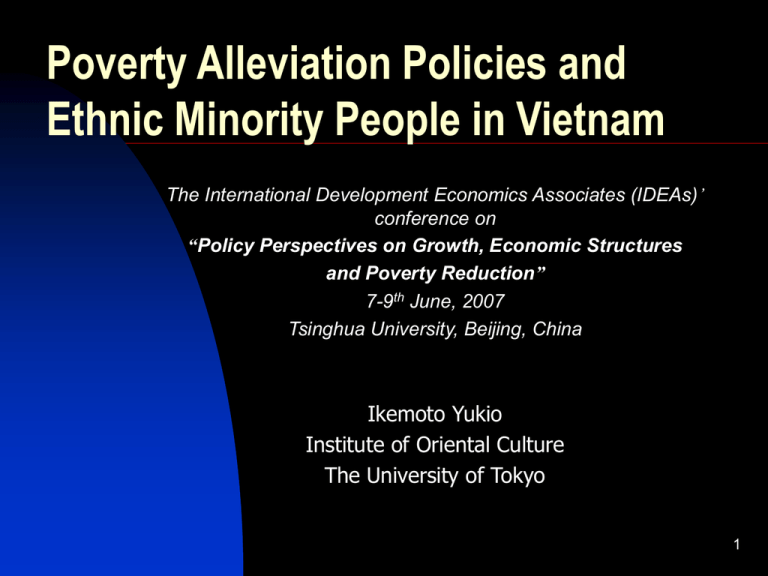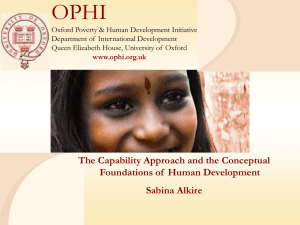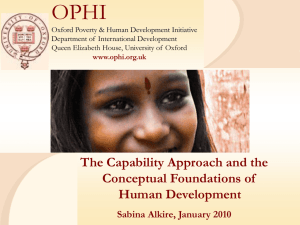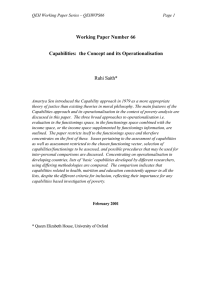Poverty alleviation policies and ethnic minority people in
advertisement

Poverty Alleviation Policies and Ethnic Minority People in Vietnam The International Development Economics Associates (IDEAs)’ conference on “Policy Perspectives on Growth, Economic Structures and Poverty Reduction” 7-9th June, 2007 Tsinghua University, Beijing, China Ikemoto Yukio Institute of Oriental Culture The University of Tokyo 1 Purpose To discuss the “efficiency” of the capability approach of Amartya Sen. Efficiency is the shortest way to achieve the goal. Capability approach is concerned with how to define our goal; or how to define “poverty.” To see the moon, not the finger that points to the moon. "Life is like a finger, pointing to the Moon. If you look at the finger... you will miss all the heavenly glory." (Bruce Lee) Prof. Kregel mentioned “We have to know what it is before we know what causes it. 2 Human Development and Capability Association (HDCA), 2003- Ikemoto Yukio, “Poverty, Ethnic Minority, and Culture: A Case in Vietnam,” presented at the Conference on "Justice and Poverty: examining Sen's Capability Approach" (5-7 June 2001, Von Hügel Institute, St Edmund's College, University of Cambridge), 2001. http://www.st-edmunds.cam.ac.uk/ vhi/sen/papers/ikemoto.pdf 3 Background JICA (Japan International Cooperation Agency) A big project for policy reform for Vietnamese government. Poverty alleviation policy for ethnic minority people in the central highland. “Are they really poor?” “Who makes them poor?” “What are the real problems of low income?” 4 Fig. 1 pove rty incid ence 5 Poverty incidence Population Share Incidence of Poverty Distribution of the Poor 1993 1998 1993 1998 1993 1998 All 100 100 58 37 100.0 100.0 Kinh 87 86 54 31 80.8 71.7 Minority 13 14 86 75 19.2 28.3 6 Official Poverty line Food poverty line Overall poverty line Poverty dramatically decreased. 7 Limits of income approach Regional variation from the north to the south Vietnam. Cultural diversification Practical problems to identify who are poor. Income approach is impractical. 8 Commodity approach (1)Poor households: More than 40% of households in the commune is poor. (2)Transportation: Poor communes locate more than 20 km away from a development center that has hospital, school, government office and other basic infrastructures. (3)Key infrastructure: Poor communes lack electricity, road, irrigation, clean water supply, school, hospital, and so on. (4)Social indicators: Illiteracy rate of poor communes exceeds 60%. 9 Arbitrariness of commodity approach Anything that can be considered as a criterion can be included. Unnecessary investment Waste of national budget Needs may be different according to their living condition, climate, culture, etc. 10 The Capability Approach Both income and goods may not be adequate to measure human well-being. Utility (happiness) is not appropriate because of adaptive preference. We should focus on what a person can do and can be, which is called functionings. Capability is a set of vectors of functionings. 11 List of functionings 1 (1) a. b. c. d. e. f. Elementary functionings Adequately nourished Free from avoidable disease Avoiding premature mortality Adequately educated Having essential non-food consumption goods Being well-sheltered 12 List of functionings 2 (2) Complex functionings g. Being happy h. Taking part in the life of the community I. Having self-respect (3) Trivial functionings j. Playing golf 13 Nussbaum’s list Capability approach used for political purpose. Sen does not agree to present a list. He emphasized it is an approach and that it was not originally intended to “operationalize”. 14 Informational base: Data Sen (1985) discussed relationship between data and approach. Capability approach can utilize non-economic data, which are actually more abundant than market data. 15 So what? The capability approach intends to expand the informational base. Why do economists focus on income? Can income solve any problems? This is assumed in economics. Hypothesis of economics: Maximize utility which is determined by income. 16 Table X-1. Inequality, Poverty and Malnutrition in Thailand Year Gini Poverty Malnutrition coefficient Incidence Total 2nd degree 1979 56.0% 13.1% 1981 0.431 17.5% 1982 58.0% 13.0% 1983 48.0% 11.8% 1984 35.2% 5.9% 1985 28.5% 3.9% 1986 0.466 22.4% 26.0% 3.2% 1987 23.5% 2.4% 1988 0.474 16.1% 22.0% 2.0% 1989 20.6% 1.3% 1990 0.488 15.0% 18.6% 0.8% 1992 0.515 10.9% Malnutrition in Thailand 3 degree rd 2.0% 2.1% 1.9% 0.8% 0.21% 0.13% 0.06% 0.04% 0.01% 0.004% 17 Capability and economics Maximize capability set. A.K. Sen, Development as Freedom, 1999. Maximize weighted functionings ? What are the weights? What are the functionings to be chosen? Little change in formulation can make significant differences in development path. 18 Thank you! 19







